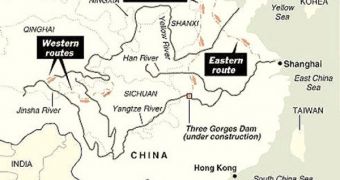Like anything else done in China recently, the envisioned South-to-North Water Diversion Project will take place on a gargantuan scale. Essentially, it goes something like this: the northern parts of the country have little water reserves, while the South has some that it can spare. Therefore, a route of channels covering hundreds of miles will be built that will take the precious liquid to cities such as the capital Beijing, Tianjin and Shanghai, the BBC News reports.
However, in the regions where the glorious canals will be built, the resident population has remained a problem until now. The Chinese government has decided to move some of the inhabitants in the Henan and Hubei provinces, a mere 330,000 individuals, out of the way. The tactic is similar to the one the Communist authorities applied when they constructed the massive Three Gorges Dam, whose reservoir spans hundreds of miles. People there were relocated to nearby cities, so that the valley they once inhabited could be flooded to produce electrical energy.
The name of the project, however, does not cover its entire span. Water from the southern, central and western China will be taken to the arid North through three sets of massive canals that will ensure the capital city is no longer short on water. The project is estimated to cost the government about $62 billion, a figure that dwarfs the $39 billion paid for the largest dam in the world. The thing is that the initiative, which was first thought of by now-defunct Chairman Mao Zedong, is already more than four years behind schedule.
According to the official Chinese new agency, Xinhua, the dislodged residents of the two provinces will be moved in newly built villages and will receive annual payments in the amount of $88. However, the current figure of 330,000 people pales in comparison with the massive 1.3 million citizens that the government had to relocate to make way for the massive reservoir of the Three Gorges Dam. Environmental activists are, however, very critical of the plans, saying that the scheme will not only cause massive damage to the ecosystem, but will also fail to resolve the problems in the arid North. The only solution, they say, is to conserve the little water the North already has, through comprehensive schemes.

 14 DAY TRIAL //
14 DAY TRIAL //